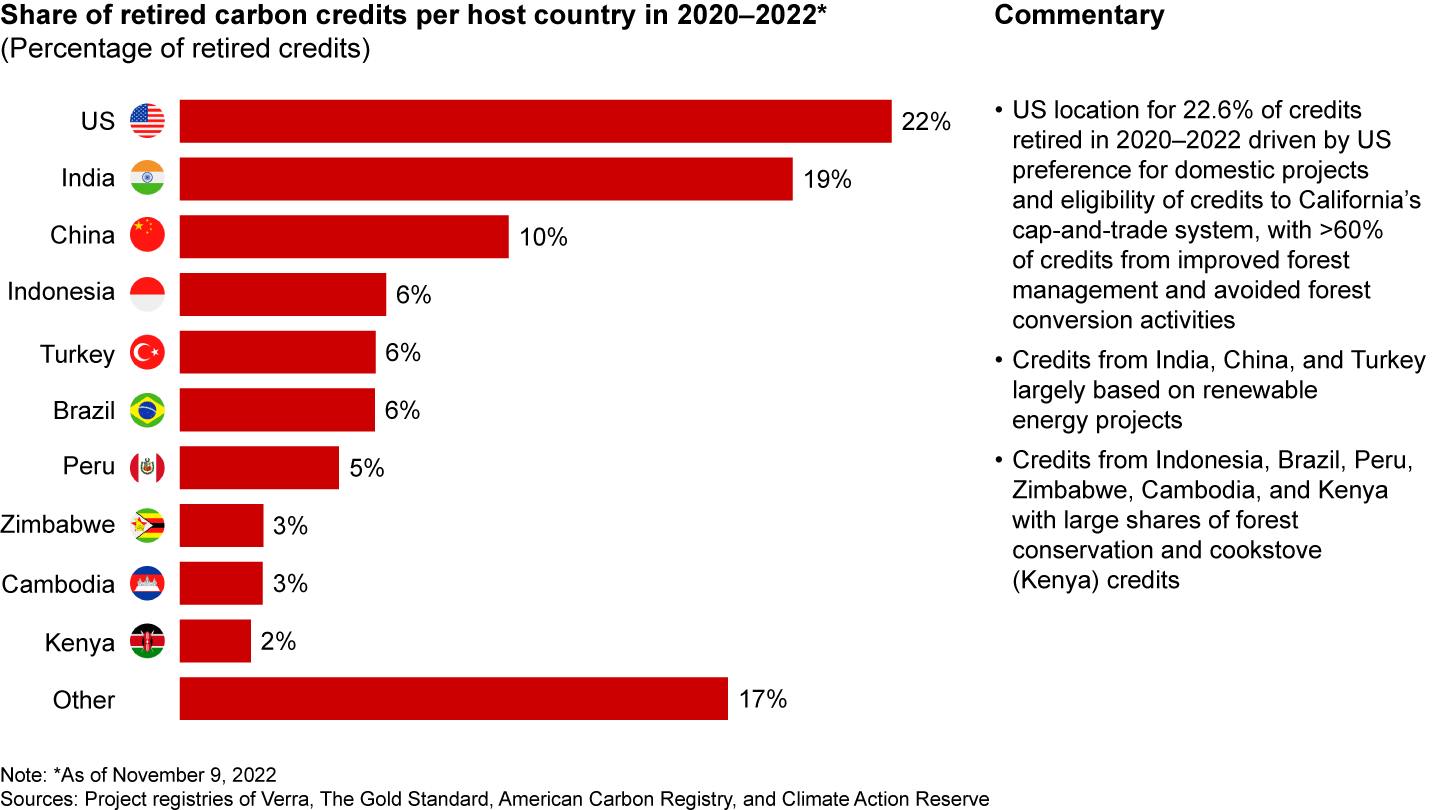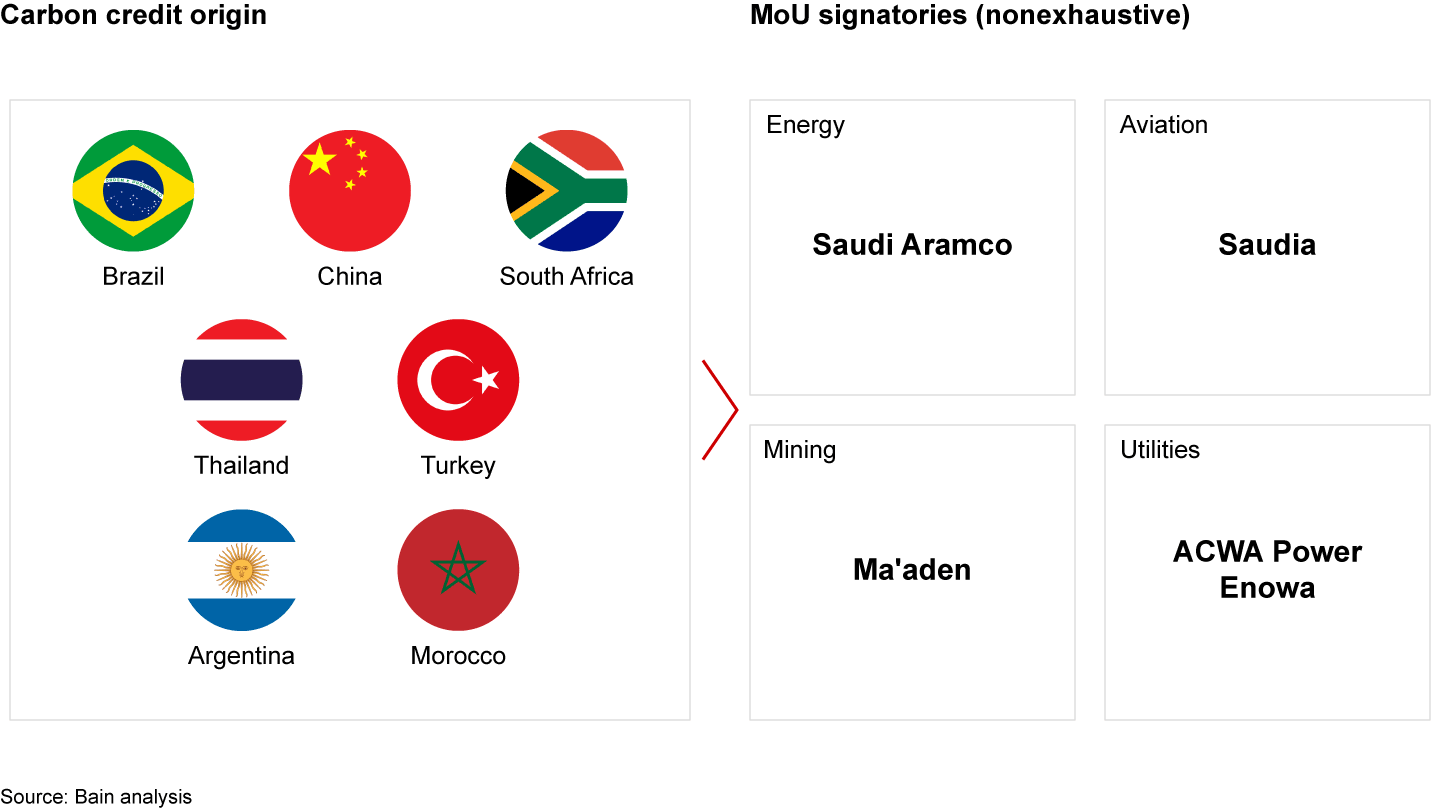Brief

The proverbial alarm bell on swift action to reduce greenhouse gas emissions has long been sounding. While many hear its clang, clear and actionable direction on achieving net zero emissions can be complex, as it requires a combination of mature and early-stage solutions. Commitment to energy efficiency and renewable energy were, at one time, the standard in sustainability initiatives. But these actions alone are no longer sufficient to achieve climate ambitions aligned with the Paris Agreement.
Success will require stakeholders to go beyond current efforts. In addition to the development and scale-up of new technologies (such as carbon capture and clean hydrogen use cases), access to mitigation projects outside their own value chain will be critical. Implementing a policy of carbon offsets (the reduction of emissions to make up for unavoidable emissions elsewhere) and carbon credits (permits that allow for a certain amount of emissions that can be traded if not used) enables the development of carbon removal levers (e.g., nature-based solutions [NBS] and technology development) (see Figure 1).


Leading economies in the Gulf Cooperation Council (GCC) like the Kingdom of Saudi Arabia (KSA), United Arab Emirates (UAE), and Oman have announced ambitions to reach net zero emissions by 2060 (KSA) and 2050 (UAE and Oman), with decarbonization strategies that rely on a mix of well-established levers (renewable energy, energy efficiency) and forward-looking carbon abatement solutions (hydrogen, carbon capture, and NBS). During the past year they also revised their 2030 nationally determined contributions (NDCs), national climate commitments submitted to the UN under the Paris Agreement, and announced that they will use a wide array of decarbonization levers to meet them (see Figure 2).


The value in voluntary carbon offset markets
A voluntary carbon market, which connects the supply of carbon credits with demand from investors and organizations wanting to reduce their carbon footprint, is experiencing rapid growth around the world. While we have seen several initiative examples in the region, such as establishing exchanges, the practice is still in its infancy in the GCC and there is limited demand and supply compared to other regions (see Figure 3 and Figure 4).




The GCC has already taken a few steps in the right direction to tailor the regional voluntary carbon market to regional needs and specificities while complying with upcoming international trade agreements:
- Exchanges: In KSA, the Public Investment Fund (PIF) and Saudi Stock Exchange, Tadāwul, announced a joint plan to establish a voluntary carbon exchange in Riyadh by 2023 for the trading of verified, approved, and high-quality carbon credit certificates. In UAE, Abu Dhabi Global Market (ADGM) announced the formation of a voluntary carbon credit trading exchange and clearinghouse. Also in UAE, Mubadala Investment Company acquired a strategic stake in AirCarbon Exchange (ACX).
- Market activation: In October 2022, PIF and Tadāwul established a voluntary carbon market entity in charge of sourcing and auctioning high-quality carbon offsets. In conjunction with the Financial Investment Initiative held in Riyadh, they auctioned more than 1 million carbon offsets that complied with Carbon Offsetting and Reduction Scheme for International Aviation (CORSIA) regulations and were Verra certified (see Figure 5).
- Issuance scheme: KSA launched a domestic carbon credit scheme at the start of 2023 that will issue credits compliant with Article 6 of the Paris Agreement.
- Financing: KSA-based investment fund APICORP issued a $75 million funding facility for voluntary carbon offset projects.
- Industrials: Large emitters are starting to be active in this space, with stakeholders in energy, aviation, mining, and utilities signing memorandums of understanding (MoUs) for carbon credit offtakes.


Way forward
It is imperative for governments to establish the infrastructure for the voluntary carbon market and clarify carbon ownership. This will be a critical prerequisite for GCC countries to ensure alignment between private sector efforts and their NDCs. In addition, there is currently a lack of clarity on how to issue certificates for select carbon abatement technologies, such as carbon capture, utilization and storage (CCUS). Providing clear certification guidelines will enable investors to make guided decisions (see Figure 6).


Lessons from a popular carbon offsetting project in the Philippines show that establishing a new regulatory structure, including a national projects registry, can help set up a market structure that attracts investors by playing on two dimensions:
- Policy certainty: Demonstration of steady progress in providing clear policy direction for all market participants.
- Openness to foreign trade: The Philippines intends to participate in the international carbon markets and designed its legislation in line with the Paris Agreement’s Article 6 requirements.
Action levers for stakeholders
Voluntary carbon credits provide a possible pathway from private investment sources to climate-action projects that would not otherwise receive funding.
Financiers: Financial institutions are instrumental in building scale in voluntary carbon markets. They can accelerate the transition to net zero by seizing opportunities from the carbon credit market. Unfortunately, there is currently a financing shortfall for high-quality carbon removal solutions. To lift the market off the ground, financial institutions and asset managers should develop the financial instruments necessary to structure the carbon market, including project financing, exchanges, direct investments, and advising.
Hard-to abate-industries: There are currently few cost-efficient emission reduction solutions for energy-intensive sectors. These industries need to invest in research and development (R&D) to develop low-carbon technologies whose deployment and rollout will take time. In the intermediate state, voluntary carbon markets provide a solution for corporations to accelerate decarbonization beyond value chain mitigation. Participation in the voluntary carbon market is, therefore, inevitable for those operating in industries that are “hard to abate,” are governed by emission regulations, or have announced net zero operational ambitions.
Hard-to-abate industries, such as utilities, aviation, and heavy industrials, face a dilemma. Despite several net zero announcements by GCC companies (e.g., Saudi Aramco) or industry alliances with GCC members (e.g., the International Air Transport Association [IATA], of which major GCC airlines are members), there are currently few cost-efficient emission reduction solutions. But participation in the voluntary carbon market will play a major role in accelerating progress on decarbonization efforts.
Leading regional industrial players will ultimately be driven to operate in the voluntary carbon market. Even if the carbon market currently lacks maturity and transparency, it is the right time to start building internal capabilities. This includes developing the optimal operating model and strategic recruitment strategies to minimize the risk of misallocated capital.
Global companies in various sectors, investment banks, and commodity trading professionals are reporting success with operating model archetypes varying from over-the-counter (OTC) trading to proprietary project development.
Looking ahead
More than ever, organizations are in the position of looking beyond their ambitions and commitments to carbon offsets. As global policy becomes more prominent and complex, stakeholders can take these steps to be better positioned:
- Government entities: Provide clarity on the overall legal infrastructure around voluntary carbon markets, carbon rights, and credit additionality
- Industrials: Ramp up internal capabilities to ensure readiness to play in voluntary carbon markets as a mitigation after investing in decarbonization and R&D for low-carbon technologies
- Financial sector: Develop financial infrastructure to help fund projects where carbon credits are critical to reach economic feasibility